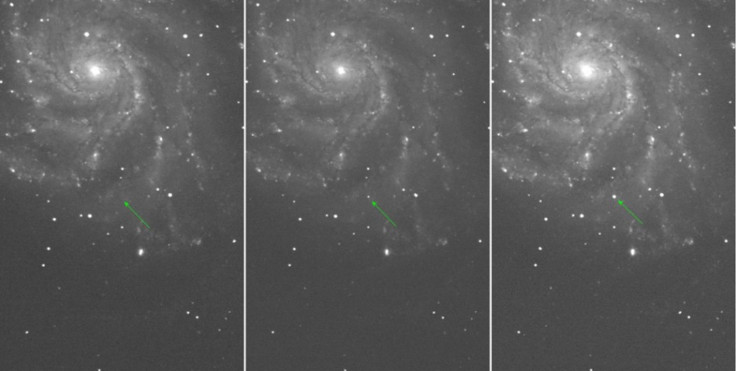'Supernova of a Generation': Brightest Exploding Star in 40 Years Spotted

Astronomers from Berkeley have discovered the closest supernova, or exploded star, in 40 years in the Pinwheel Galaxy, located just 21 million light-years from Earth.
On Tuesday night, the supernova exploded in the Pinwheel Galaxy, which was the closest star explosion of its type observed since 1972, according to astronomers.
The type Ia supernova, which researchers believe they caught within hours of its explosion, was dubbed as PTF11kly. The supernova is getting brighter and could be visible with a good pair of binoculars in the next 10 days.
PTF 11kly is getting brighter by the minute. It's already 20 times brighter than it was yesterday, Peter Nugent, of the Lawrence Berkeley National Laboratory and the University of California, Berkeley, said in a statement on Wednesday.
Observing PTF 11kly unfold should be a wild ride, said Nugent, who was the first person to spot the supernova. It is an instant cosmic classic.
Scientists from the University of Oxford made the discovery with their colleagues using the Palomar Transient Factory survey. The employed a robotic telescope in California in the United States.
The PTF 11kly was spotted blazing up in the Big Dipper, also known as the constellation Ursa Major. The new supernova is a Type Ia supernova. Type Ia supernovas are the result of a binary pair of mismatched stars, the smaller, denser one feeding on material drawn off its larger companion, until it can no longer take in any more material. Then it explodes in a catastrophic event that outshines the brightness of its entire galaxy, Universe Today reported.
Being the source of most of the chemical elements in the universe heavier than iron, supernovas also play an important role in the evolution of galaxies and planetary systems. They also seed the rest of space with elements such as carbon, oxygen and nitrogen, and can nudge gas clouds into collapsing to form new star systems.
Over the next couple of weeks, researchers will be having a close look at the supernova, catching its formation and evolution.
The most exciting thing is that this is what's known as a type 1a supernova, the kind we use to measure the expansion of the universe. Seeing one explode so close by allows us to study these events in unprecedented detail, said Oxford team leader Mark Sullivan.
The best time to see this exploding star will be just after evening twilight in the Northern Hemisphere in a week or so, Sullivan Said. You'll need dark skies and a good pair of binoculars, although a small telescope would be even better.
More than 1,000 supernovae have been discovered by the scientists in PTF, since it started operating in 2008, but they believe this could be their most significant discovery yet.
We are finding new clues to solving the mystery of the origin of these supernovae that has perplexed us for 70 years, said Andrew Howell of UC Santa Barbara. Despite looking at thousands of supernovae, I've never seen anything like this before.
The last time a supernova of this sort occurred so close was in 1972. They are calling the latest exploding star as supernova of a generation.
© Copyright IBTimes 2025. All rights reserved.






















